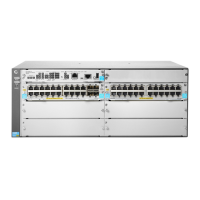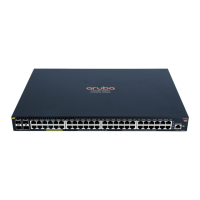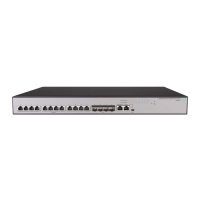71
• Max age
The device uses the max age to determine whether a stored configuration BPDU has expired
and discards it if the max age is exceeded.
RSTP
RSTP achieves rapid network convergence by allowing a newly elected root port or designated port
to enter the forwarding state much faster than STP.
A newly elected RSTP root port rapidly enters the forwarding state when the following conditions
exist:
• The old root port on the device has stopped forwarding data.
• The upstream designated port has started forwarding data.
A newly elected RSTP designated port rapidly enters the forwarding state if it is an edge port or it
connects to a point-to-point link.
• A port that directly connects to a user terminal can be configured as an edge port. Edge ports
directly enter the forwarding state.
• When a designated port connects to a point-to-point link, it enters the forwarding state
immediately after the device receives a handshake response from the directly connected
device.
PVST
In an STP- or RSTP-enabled LAN, all bridges share one spanning tree. Traffic from all VLANs is
forwarded along the spanning tree, and ports cannot be blocked on a per-VLAN basis to prune loops.
PVST allows every VLAN to have its own spanning tree, which increases utilization of links and
bandwidth. Because each VLAN runs STP or RSTP independently, a spanning tree only serves its
VLAN.
A PVST-enabled HPE device can communicate with a third-party device that is running Rapid PVST
or PVST. The PVST-enabled HPE device supports fast network convergence like RSTP when
connected to PVST-enabled HPE devices or third-party devices enabled with Rapid PVST.
A port's link type determines the type of BPDUs the port sends.
• An access port sends STP BPDUs.
• A trunk or hybrid port sends STP BPDUs in VLAN 1 and sends PVST BPDUs in other VLANs.
MSTP
MSTP overcomes the following STP, RSTP, and PVST limitations:
• STP limitations—STP does not support rapid state transition of ports. A newly elected port
must wait twice the forward delay time before it transits to the forwarding state.
• RSTP limitations—Although RSTP enables faster network convergence than STP, RSTP fails
to provide load balancing among VLANs. As with STP, all RSTP bridges in a LAN share one
spanning tree and forward packets from all VLANs along this spanning tree.
• PVST limitations—Because each VLAN has its spanning tree, the amount of PVST BPDUs is
proportional to the number of VLANs on a trunk or hybrid port. When the trunk or hybrid port
permits too many VLANs, both resources and calculations for maintaining the VLAN spanning
trees increase dramatically. If a status change occurs on the trunk or hybrid port that permits
multiple VLANs, the device CPU will be overburdened with recalculating the affected spanning
trees. As a result, network performance is degraded.

